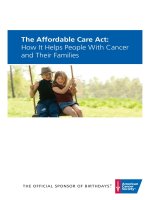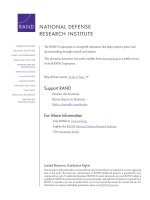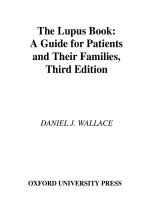The contribution and impact of sele enat charitable organization in fulfilling the needs of destitute children and their families
Bạn đang xem bản rút gọn của tài liệu. Xem và tải ngay bản đầy đủ của tài liệu tại đây (915.84 KB, 94 trang )
The Contribution and Impact of Sele Enat Charitable Organization in Fulfilling the
Needs of Destitute Children and Their Families
By
Tigist Bazezew
A Thesis Submitted to the Graduate Studies of Addis Ababa University in Partial
Fulfillment of the Requirements for the Degree of Masters in Social Work
Addis Ababa University
Faculty of Social Sciences
School of Social Work
June, 2017
Addis Ababa, Ethiopia
1
The Contribution and Impact of Sele Enat Charitable Organization in Fulfilling the
Needs of Destitute Children and Their Families
By
Tigist Bazezew
A Thesis Submitted to the Graduate Studies of Addis Ababa University in Partial
Fulfillment of the Requirements for the Degree of Masters in Social Work
Addis Ababa University
Faculty of Social Sciences
School of Social Work
Advisor: Adamnesh Atnafu (PhD)
June, 2017
Addis Ababa, Ethiopia
2
ADDIS ABABA UNIVERSITY
SCHOOL OF GRADUATE STUDIES
EXAMINING COMMITTEE
This is to certify that the thesis prepared by Tigist Bazezew titled: The Contribution and Impact Sele
Enat Charitable Organization in Fulfilling the Needs of Destitute Children and Their
Families; submitted in partial fulfillment of the requirements of Degree of Master of Arts (School of Social
Work) complies with the regulation of the university and meets the accepted standards with respect to
originality and quality.
Signed by the Examining Committee:
Examiner _______________________ Signature ________________ Date _________________
Examiner _______________________ Signature ________________ Date _________________
Advisor ________________________ Signature _________________ Date ________________
1
Acknowledgements
First I would like to thank God for helping me throughout my study. My heartfelt gratitude goes
to my dedicated advisor, Dr. Adamnesh Atnafu for her unreserved assistance and constructive
comments.
My deepest gratitude should also go to my parents, my father Ato Bazezew Kebede and my
mother W/ro Abeba Kinde for their unfailing support throughout my study.
I am very much grateful to Ato Zelalem Eteffa, Vice Manager of Sele Enat Charitable
Organization for his genuine cooperation and continuous provision of information. Then my
appreciation goes to Ato Betemariam Hailu, Social Worker of Sele Enat Charitable Organization
for his consistent collaboration throughout the study.
In addition, I am indebted to Yohannes Shiferaw for his substantial encouragement via providing
crucial comments and literatures. I am also grateful for Selamawit Imiru for offering helpful
suggestions and documents.
Finally, I convey special acknowledgement to all participants of the study. It would not be
possible to accomplish this study and achieve the intended outcome without the cooperation of
the participants.
2
Table of Contents
Contents
Page
Table of Contents .......................................................................................................................... 3
Abbreviations ................................................................................................................................ 5
Terms to Define ............................................................................................................................. 6
Operational Definition of Terms ................................................................................................. 7
CHAPTER ONE
1.
Introduction ........................................................................................................................... 9
1.1
Background .......................................................................................................................9
1.2
Statement of the Problem ................................................................................................. 10
1.3
Objectives ........................................................................................................................ 12
1.3.1
General Objective ..................................................................................................... 12
1.3.2
Specific Objectives .................................................................................................... 12
1.4
Research Questions .......................................................................................................... 13
1.5
Significance of the Study .................................................................................................. 13
1.6
Scope of the Study ............................................................................................................ 13
1.7
Limitation of the Study .................................................................................................... 14
CHAPTER TWO
2. Literature Review ................................................................................................................... 15
2.1 Community Based Child Care ............................................................................................... 15
2.3 Factors for Children’s Vulnerability ..................................................................................... 17
2.4 History of Community Based Child Care in Ethiopia ............................................................ 23
2.5 Services of Community Based Child Care Programs ............................................................. 25
CHAPTER THREE
3. Research Method………………………………………………………………………….....30
3.1
Research Design ............................................................................................................... 29
3.2
Study Area ....................................................................................................................... 31
3.3
Participants of the Study .................................................................................................. 31
3.4
Sampling .......................................................................................................................... 31
3.5
Data Collection Tools ....................................................................................................... 32
3.5.1
Observation .............................................................................................................. 33
3.5.2
In-depth Interview .................................................................................................... 33
3
3.6
Data Analysis Techniques ................................................................................................ 34
3.7
Ethical Considerations ..................................................................................................... 35
CHAPTER FOUR
4.
Findings ................................................................................................................................ 36
4.1
Services Provided by Sele Enat Charitable Organization ................................................. 36
4.2
The Economic and Social Impacts of Sele Enat Organization Child Sponsorship on
Destitute Children and Their Families ........................................................................................ 42
4.2.1
The Economic Impacts of the Program ..................................................................... 42
4.2.2
The Social Impacts of the Program ........................................................................... 47
4.3
Opportunities and Threats of Sele Enat Organization Child Sponsorship Program......... 50
4.3.1
Opportunities of the program ................................................................................... 50
4.7.2 Threats of the program ................................................................................................... 52
4.4
Strengths and Gaps of Sele Enat Organization Child Sponsorship Program.................... 53
4.4.1
Strengths of the program .......................................................................................... 53
4.4.2
Gaps of the Program ................................................................................................. 57
4.5
Case Stories of Graduates ............................................................................................... 60
CHAPTER FIVE
5.
Discussion ............................................................................................................................. 66
5.1
Destitute Children in Ethiopia ......................................................................................... 66
5.2
Factors for Vulnerability of Children............................................................................... 67
5.3
Community Based Child Care ......................................................................................... 68
5.4
Services Provided by Sele Enat Child Sponsorship Program ........................................... 68
5.5
Economic and Social Impacts Sele Enat Child Sponsorship Program .............................. 69
5.6
Strengths of Sele Enat Child Sponsorship Program ......................................................... 71
5.7
Gaps of Sele Enat Child Sponsorship Program ................................................................ 73
5.8
Implication of the Findings to Social Work Profession ..................................................... 74
CHAPTER SIX
6.
Conclusion and Recommendation ...................................................................................... 78
6.1
Conclusion ....................................................................................................................... 78
6.2
Recommendation ............................................................................................................. 80
Reference ..................................................................................................................................... 82
Annexes
4
Abbreviations
AIDS: Acquired Immune Deficiency Syndrome
CBO: Community Based Organization
HIV: Human Immune Virus
IGP: Income Generating Program
MoLSA: Ministry of Labor and Social Affairs
MOWA: Ministry of Women, Children and Youth Affairs
MOJ: Ministry of Justice
NGO: Non-Governmental Organization
OVC: Orphan and Vulnerable Children
UNICEF: United Nations Children Emergency Fund
UNCRC: United Nations Convention on the Right of the Child
5
Terms to Define
Enjera: A circle bread mostly made of a grain named teff and a customary meal for Ethiopians.
Idir: A local institution initiated and lead by the members themselves and provides care and
support for its members during mourning.
Iquib: A local saving and credit association that is administered by selected members.
Madego: An Ethiopian tradition of assuming the parenting of a child from the child’s biological
or legal parent or parents, and, in so doing permanently transfers all rights and responsibilities
along with filiation from the biological parent or parents (Tsegaye, 2008).
Woreda: The smallest government administrative structure in Ethiopia.
6
Operational Definition of Terms
Child: For the purpose of this study the term child refers to a child between the age of 4 up to 18
and is part of the child sponsorship program of Sele Enat Charitable Organization.
Community Based Organization (CBO): refers to a public or private non-profit organization of
demonstrated effectiveness that is representative of a community or significant segments of a
community, and provides educational or related services to individuals in the community.
Destitute children: stands for children who are left without means of subsistence; deprived of
their basic necessities such as food, clothing and shelter.
Needs: For the purpose of the study, the term needs refers to the economic and social needs of
children.
7
Abstract
This research has dealt with the contribution and impact of Sele Enat Charitable Organization in
fulfilling the needs of destitute children and their families with a general objective to assess the
services of the organization to measure their contribution and impacts. The study has specific
objectives of identifying the services provided by the organization, assessing the economic and
social impacts of the service and identifying the strengths and gaps of the organization. This
research is a qualitative study. The study followed descriptive phenomenological approach.
Using purposive sampling of 8 client mothers, 2 staff members of the organization, and 2
graduate children who were part of the child sponsorship program with total number of 12
participants have participated in the study. The data has been collected via observation and indepth interview that has been developed referring to different literatures and objectives of the
research. Thus, the findings of the study were analyzed using qualitative data analysis methods.
The process of data collection and data analysis were conducted concurrently. In general, the
findings of the research indicated that Sele Enat Charity Organization’s child sponsorship
program has been delivering several services and brought significant economic and social
impacts on the lives of destitute children and their families via providing monthly stipend for
basic needs, clothing, educational support, health care service and women empowerment
programs.
8
CHAPTER ONE
1. Introduction
1.1 Background
According to MoLSA 2005, the population in Ethiopia is generally characterized by a
very young structure, with children below 18 years accounting to 52% of the national population.
The number of children living in difficult circumstances is noted to be significant due to social,
economic, political as well as cultural factors. It is currently estimated that there are about 4.6
million orphans, out of which 1 million have lost their parents due to AIDS. According to
UNICEF 2001, there are at least 100,000 street children in Ethiopia (about 25% are girls.)
UNICEF’s projected estimate puts the figure to 185,000 in 2003. Children with disabilities
account for 51%, out of the estimated 4.9 million persons with some disability in the country. It
is to be noted that there is also a large number of Ethiopian children who are in conflict with the
law, children working in hazardous conditions, displaced and refugee children (as cited in
Alternative Childcare Guidelines, 2009). This implies that, there is significant number of needy
children looking for the intervention of concerned stakeholders.
In Ethiopia, 73 percent of children under age 18 live with both parents, 12 percent live
with their mother only, 4 percent live with their father only, and 10 percent live with neither
parents. In 2005, Ethiopia was home to estimated 77,000 unaccompanied child-headed
households, second only to Zimbabwe in sub-Saharan Africa. Rural children are more likely than
urban children to live with both parents. The highest proportion of children living with both
parents is in the Somali Region (79 percent), whereas the lowest proportion lives in Addis Ababa
(49 percent) (FHI, 2010).
9
Consequently, families and communities need various forms of assistance to cater for the
needs of unattended and maltreated children. Besides, there are high number of women headed
households facing several economic challenges.
The particular issue the researcher wanted to study is about the contribution of
community based child care services in fulfilling the needs of destitute children and their
families. Here are a few reasons that initiated the researcher to study this subject. The first one is,
because the researcher believes that needy children should get the necessary provision while they
remain in their families. Hence, the researcher wanted to assess the contribution of community
based support needy children and their families receive. The second reason is, because the
researcher had an interest to learn about the living condition of destitute children and their
families, the provision they obtain from concerned stake holders and economic and social
impacts of the support on their lives.
1.2 Statement of the Problem
The situation of destitute children and supports provided to them are major issues in the
world and particularly in Ethiopia. Several researches have been conducted to assess the
situation, needs, services and policies regarding destitute children at various corners of the
country. Among these researches some of them were undertaken by international organizations
and Non-Governmental Organizations (NGOs) while the rest were conducted by governmental
organizations.
As a result of the existing low level of socio-economic status of the country, exacerbated
by recurrent drought and war, millions of children in Ethiopia are deprived of the right with basic
needs and survival. The situation is exacerbated by the AIDS pandemic ravaging the country and
deteriorating the active labor force that can play a significant role in the future socio-economic
10
development of the nation. The Ministry of Labor and Social Affairs (MoLSA) estimates those
disadvantaged children who are victims of all the above factors to be approximately 5 million
(Tsegaye, 2008).
While numerous institutions were created to care for orphan and vulnerable children
national, international and governmental organizations were also experimenting providing
alternative care for orphans and unaccompanied minors. These alternative cares include
community based care, reunification and reintegration, foster care and adoption. A few national
and international organizations such as the Ethiopian Evangelical Church Mekane Yesus,
Christian Children’s Fund USA and Canada have attempted to solve the problem through noninstitutional approaches that include family sponsorship programs and day care centers. Children
(orphan and destitute) were provided with meals, education, medical care and clothing.
Policies and procedures that address to the needs of orphan and vulnerable children both at the
micro and macro level are in the process of shifting from institutional care to family and
community based services. Accordingly, individual NGOs have nearly stopped initiating new
orphanages. Government organizations also took a bold initiative of reunifying and reintegrating
the children under their custody (FDRE, 2010).
Community based child care has been catering for the needs of significant number of
destitute children and families. However, there is still substantial number of needy children and
families looking for some sort of assistance. Besides, community based child care is mentioned
as the best alternative among the other child care options. In addition, according to the Ethiopian
childcare guideline, 2009, community based child care is the only alternative that supports both
destitute children and their families since the others are restricted to vulnerable children.
Nevertheless, most families who have been supported through community based child care
11
programs could not change their lives permanently and become self-reliant though they managed
to survive and cater for the needs of their children to the minimum. Therefore, the researcher
wants to study the contribution and, economic and social impacts of the community based child
care. Therefore, this study attempts to address these issues under related themes.
According to the literatures reviewed, studies have been conducted to assess the services
provided by community based organization and their contribution on the development of needy
children. However, there is a gap in identifying the economic and social impacts of the services
and strengths and gaps of the current community based child care practice. Hence, this study
tries to address these gaps under their respective themes.
1.3 Objectives
1.3.1
General Objective
The overall objective of the study is to assess the services of Sele Enat Charitable
Organization to measure their contribution and impacts to fulfill the needs of destitute children
and their families.
1.3.2
Specific Objectives
Identifying the services provided by Sele Enat Charitable Organization to achieve
effective child care
Assessing the social and economic impacts of Sele Enat Charitable Organization’s
community based service on the wellbeing of destitute children and their families
Identifying the strengths and gaps of the current community based childcare practice of
Sele Enat Charitable Organization
12
1.4 Research Questions
What are the services provided by Sele Enat Charitable Organization’s community based
child care program to fulfill the needs of destitute children and their families?
What are the economic and social impacts of Sele Enat Charitable Organization’s
community based child care on the wellbeing of destitute children and their families?
What are the strengths and gaps of Sele Enat Charitable Organization’s community based
child care in achieving its purpose?
1.5 Significance of the Study
This research has intended to assess the contribution of community based organizations
in fulfilling the needs of destitute children and their families focusing on Sele Enat Charitable
Organization. Therefore, the result of this study will provide an input to enhance the quality of
service provided to destitute children and their families through showing the impacts and,
strengths and gaps of the current community based child care practice. In addition, this study will
serve as a benchmark for community based organization to evaluate their services and impacts
while delivering service for destitute children and their families. Furthermore, this study will
serve as a reference for upcoming researchers who want to conduct studies on the service of
community based organizations.
1.6 Scope of the Study
This study was restricted to the contribution and impacts of community based child care
in fulfilling the needs of destitute children. The target population of the study was limited to Sele
Enat Charitable Organization community based child care clients and concerned staff members.
13
Besides, the study relied on purposive sampling so as to deal with relatively fewer respondents
so as to conduct detailed study.
1.7 Limitation of the Study
Due to different reasons every study has its own limitation. The very nature of the study
that emphasized specialized population who are difficult to reach has hampered the researcher to
look further in the area. Moreover, the focus of the study is restricted to Sele Enat Charitable
Organization child sponsorship program as a study area.
14
CHAPTER TWO
2. Literature Review
2.1 Community Based Child Care
Community based child care is an approach that provides care and support to the children
in a state of condition that is familiar to the children who used to experience it. The objective of
the community based child care service is to mobilize the community, its resources and
indigenous knowledge with the ultimate goal of addressing the needs and rights of orphans and
other vulnerable children (OVC) in a suitable manner. Practically, community based child care is
believed to be a better alternative because of the fact that it is by far cost effective and its greater
advantage of reaching large number of target children in a given community (Alternative
childcare guidelines, 2009. p20).
According to FHI, 2010 community based child care is mentioned as the best alternative
among the five child care mechanisms. There are several forms of community based child cares
which serve as alternatives for residential care. These include kinship care, foster care and
adoption. Of these alternatives, kinship care is closer to family based child care.
As it is mentioned in the above documents, community or family based child care has
been serving as the best alternative to cater for the needs of destitute children. Besides, it also
allows serving high number of needy children while they remain in their familiar setting. Hence,
it can impact the lives of several destitute children and their families. This alternative child care
system has less drawbacks than the others. It has also been observed as this form of child care
has been easy for implementation. This form of child care is known as child sponsorship
program among several stakeholders such as NGOs.
15
2.2 Situation of Destitute Children in Ethiopia
According to CSA 2007, Ethiopia’s age pyramid shows a very young population with
children between the age of 0-14 accounts for 48% and children between the 0-18 years covers
52% of the total population. The total population growth rate is estimated to be 2.76% while the
birth rate is 45.13/1000. Besides, as UNICEF 2008, estimated number of street children is
150,000-200,000. 1,000,000 urban poor children were at high risk of becoming street children. In
addition, 2.7 million children are estimated to have some sort of physical or mental disabilities.
Moreover, 9% of children between 0-18 years is reported HIV positive while 3.2 million people
are infected in Ethiopia, which is10% of the world’s total. The 2009 estimate of AIDS orphans is
around 1 million and expected to increase 2.1 million by 2014. Cumulative AIDS death was
estimated to elevate to 3.55 million and expected morbidity rate to be 5.25 by 2014. These
figures signify as Ethiopia is one of the least developed and most seriously affected countries of
the world (as cited in Tsegaye, 2008).
In Ethiopia, 73% of children under age 18 live with both parents, 12% live with their
mother only, 4% live with their father only, and 10% live with neither parents. In 2005, Ethiopia
was home to an estimated 77,000 unaccompanied child-headed households, second only to
Zimbabwe in sub-Saharan Africa. Rural children are more likely than urban children to live with
both parents. The highest proportion of children living with both parents is in the Somali Region
(79%), whereas the lowest proportion lives in Addis Ababa (49%) (FHI, 2010).
In 2009, the Ethiopian ministry of health estimated that 1,116,216 adults or 2.3% of the
total adult population of Ethiopia are living with HIV/AIDS. The final report for the Orphans and
Vulnerable Children Rapid Assessment, Analysis, and Action Planning (RAAAP) Initiative,
16
produced by UNAIDS, the World Food Program (WFP), UNICEF, USAID, and the Government
of Ethiopia, referring to the 2000 Ethiopia Demographic Health Survey (EDHS), indicates an
estimated 18% of all Ethiopian households are caring for at least one orphan. More startling is
the number of Ethiopian children (ages 0-17) identified as one or two parent orphans, which in
2005 was determined to be more than 5 million. This enormous number represents more than 6%
of the overall population of Ethiopia (Clark, 2010).
Ethiopia has ratified the UN Convention on the Rights of the child (CRC) in May 1991
and the African Charter on Rights and Welfare of the African Child in 2002. The child protection
system and more specifically, alternative care is the responsibility of three government
ministries; the MOWA, the MOJ, and the MoLSA. These three ministries are responsible for
different components. In recent years, local government and community structures, such as
woredas and idirs have taken a more proactive role in facilitating support, services, and referrals
for orphaned and vulnerable children. This community based response has been documented and
appears to be responsive to the growing needs of Ethiopia’s children (FHI, 2010).
2.3 Factors for Children’s Vulnerability
Children exposed to one or more of the vulnerability situations described below have
been categorized into children in need of special protection or children at risk. Children in need
of special protection include orphans, abandoned children, children infected or affected by
HIV/AIDS, abused children whether sexually, physically or emotionally, street children, children
in conflict with the law, children victims of exploitation whether sexually or any forms of
harmful labor, children with disabilities, children addicted to drugs and children whose basic
physical needs are not being met (Amy, 2013).
17
The category of children at risk relates to contexts of extreme poverty, breakup of the
family, alcoholism, gambling, domestic violence, dropping out from school, living in newly
resettled areas (internally displaced people/ migrants, returnees, demobilized soldier families),
and living with other than biological parents. Children who have been affected by any of these
and other vulnerability situations are eligible to receive community based child care (Kingdom
of Cambodia National Religion King, 2006 p21).
There are several factors that expose children for sever problems. Factors underlying the
vulnerability of children and lack of appropriate parental care include HIV and AIDS, natural
disasters, internal migration and chronic poverty. These factors have been documented as the
main reasons children lack parental care on a global level and, more specifically on the African
continent. The same paradigm may be applied to the situation in Ethiopia. With approximately
five million orphaned and vulnerable children, the need for alternative care options for
vulnerable children is growing (FHI, 2013).
Destitute children are constituted from orphan and vulnerable children, abandoned
children, children living in and malnourished by extreme poverty, children with disability,
children affected by armed conflicts, trafficked children, children infected with and affected by
HIV, street children, abused children (Physically, sexually, labor) and household heading
children (Getachew, 2006).
According to Amy (2013) the official definition of an orphan is a child aged zero to 17
years whose mother, father or both have died. There are, however, other children who are
referred as social orphans even though one or both of their parents may still be alive but who
18
have been unable to perform parental duties because of illness or acute poverty among other
reasons.
Children without parental care are more likely to suffer abuse and neglect, face
discrimination and exploitation, and have a host of unmet development needs. A large and
increasing number of orphan and vulnerable children (OVC) exist worldwide. According to
UNICEF, the number of single or double orphans has reached 151 million. The causes of
parental death in sub-Saharan Africa are diverse, with HIV/AIDS being one of the most
prevalent. Other factors contributing to the growing number of orphan and separated children in
sub-Saharan Africa include poverty, natural disaster, armed conflict, natural disaster, armed
conflict, disability and discrimination (FHI, 2013).
A vulnerable child is defined as being under the age of 18 years and currently at high risk
of lacking adequate care and protection. Accordingly, all children are vulnerable by nature
compared to adults but some are more critically vulnerable than others. Child vulnerability is a
downward spiral where each shock leads to a new level of vulnerability and each new level
opens up for a host of new risks (CELCIS, 2012).
Child poverty refers to the phenomenon of children living in poverty. This applies to
children that come from poor families or orphans being raised with limited or in some cases
absent state resources. Children that fail to meet the minimum acceptable standard of living for
the nation where that child lives are said to be poor. In developing countries these standards are
lower and when combined with the increased number of orphans the effects are more extreme
(Better Care Network & UNICEF, 2015).
19
Extremely poor families are not able to provide appropriate care to children in their
families. When faced with a problem such as illness and accidents, they can do something
inappropriate with their children such as abandoning, exploiting, selling or renting their children
to traffickers. In such circumstances, the child may run away (Better Care Network & UNICEF,
2015).
Children infected with and affected by HIV are the other groups of needy children due to
the consequences related to the disease. Though a small proportion of children are affected by
HIV/AIDS, the HIV/AIDS pandemic and parents dying of AIDS are causing an increase in
orphans and children living in children headed households. Even when parents are still alive,
health related expenses affect households’ economy and children caring for sick parents are
likely to drop out of school. Yet the psychological and emotional needs of children affected by
HIV/AIDS are as important as their practical needs such as food, education, health care and
shelter (SOS Children’s Village International, 2015).
Street children are the other destitute group of children who are victims of several harms.
The term street children, encompasses children in different situations. Children living on the
street have usually cut ties with their families and live all their time unsupervised on the streets.
Besides, there are children who spend a significant amount of time on the streets to provide
income for their families or for themselves. They usually have a home to return to at night. There
are also children who are members of homeless families and live with them on the streets (WHO,
2006).
The reasons for coming to the streets are rural poverty, domestic violence and remarriage.
All these children, to some extent can be exposed o physical and emotional dangers including
20
violence, gambling, delinquency, substance abuse, trafficking and prostitution that need to be
taken into account in defining effective interventions (WHO, 2006).
Abused children are the other group of deprived children who need to be part of child
care programs so as to provide them with their basic necessities and psychosocial needs. Abused
children refers to children seriously hurt through physical or emotional abuse, domestic violence,
children victims of sexual abuse such as rape, incent, indecent exposure or sexual relations with
an adult. Child abuse is a common cause for children to run away from home and it can also lead
authorities to withdraw parental authority and transfer it to an alternative care provider. The most
observed type of abused children are labor abused children who are exposed to sever forms of
jobs that do not go along with their age and physical capacity (SOS Children’s Village
International, 2015).
According to the ILO (2013) the term “child labor abuse” is often defined as work that
deprives of their childhood, their potential and their dignity, and that is harmful to physical and
mental development. It refers to work that is mentally, physically, socially or morally dangerous
and harmful to children; and interferes with their schooling; depriving them of the opportunity to
attend school; obliging them to leave school prematurely; or requiring them to attempt to
combine school attendance with excessively long and heavy work.
The other group of destitute children that needs the intervention of CBOs is children with
disability. A person with disability is any citizen who lacks any physical organ or capacity or
suffers from any mental impairment which restricts his/her daily life or activities such as
physical, visual or hearing impairment or mental handicap, and obtains a certified document
issued by ministry responsible for health. According to World Health Organization, disability is
21
a restriction or lack of ability because of impairment to perform a daily activity in the manner
within the range considered normal for human being. Children with disability are those who are
minors and have physical or mental impairment (Kingdom of Cambodia National Religion King,
2006 p24).
Trafficked children also constitute one group of vulnerable children. Trafficking of
children is a form of human trafficking and is defined as the recruitment, transportation, transfer,
harboring and/or receipt of a child for the purpose of exploration. The trafficking of children has
been internationally recognized as a serious crime that exists in every region of the world and
which often has human rights implications (ILO, 2013).
Children exposed to armed conflict, violence and displacement form another group of
destitute children. Armed conflict and violence take a heavy toll on children’s lives in different
parts of the world. Children do not only suffer from the direct consequences of war and armed
violence (recruitment in armed forces or groups, physical injuries, death), they are also indirectly
affected by displacement, loss of relatives and the trauma associated with witnessing acts of
violence (SOS Children’s Village International, 2015).
Child headed households are also part of destitute children as there is no adult household
head to take care of minor family members. A child-headed household is a group of sibling
orphans living under the responsibility and care of older children due to the passing away or
disability of their parents and other relatives. HIV/AIDS epidemic is partly a reason of growth of
such households. Some partners have recommended taking necessary measures to reduce the
growth of child-headed households and to introduce mechanisms to support existing ones
(Cambodia National Religion King, 2006).
22
The problems discussed above serve as factors for vulnerability of children. When
children are orphaned, the possibility to face problems is significantly high. Besides, HIV/AIDS
has served as a cause for vulnerability of children by causing chronic health problem and by
leaving children orphaned. Besides, abused children are destitute since they might have health
problem and psychosocial instability. Children with disability are other needy groups of children
as they have special needs. In addition, street children are also needy as they are unattended
minors. Child headed households are other vulnerable groups as they have no adult breadwinner
and head for the family. Children affected by armed conflict and trafficked are also deprived of
their rights and have psychosocial needs. Hence, all these groups of children are eligible to
receive community based care provided by concerned stakeholders.
As mentioned above, factors for vulnerability of children are several and diversified.
However, all of them are related to sever poverty and interconnected problems such as low
literacy rate and exposed life style. This implies, the problem is not limited to individual
malfunctions but also system level challenges. Therefore, interventions should be done at various
levels like vulnerable children and families, social institutions and bigger systems.
2.4 History of Community Based Child Care in Ethiopia
In Ethiopia, as in most traditional societies, there has been a strong culture of caring for
orphans (such as madego and extended family care), the sick, and disabled and other needy
members by other community members and faith based organizations. Ethiopian Evanglical
Church Mekane Yesus and the Catholic Missionaries were some of the prominent faith based
child care organizations that emerged to serve destitute children. However, the advent of
urbanization exacerbated by the recurrent drought and the resultant famine coupled with the
23









